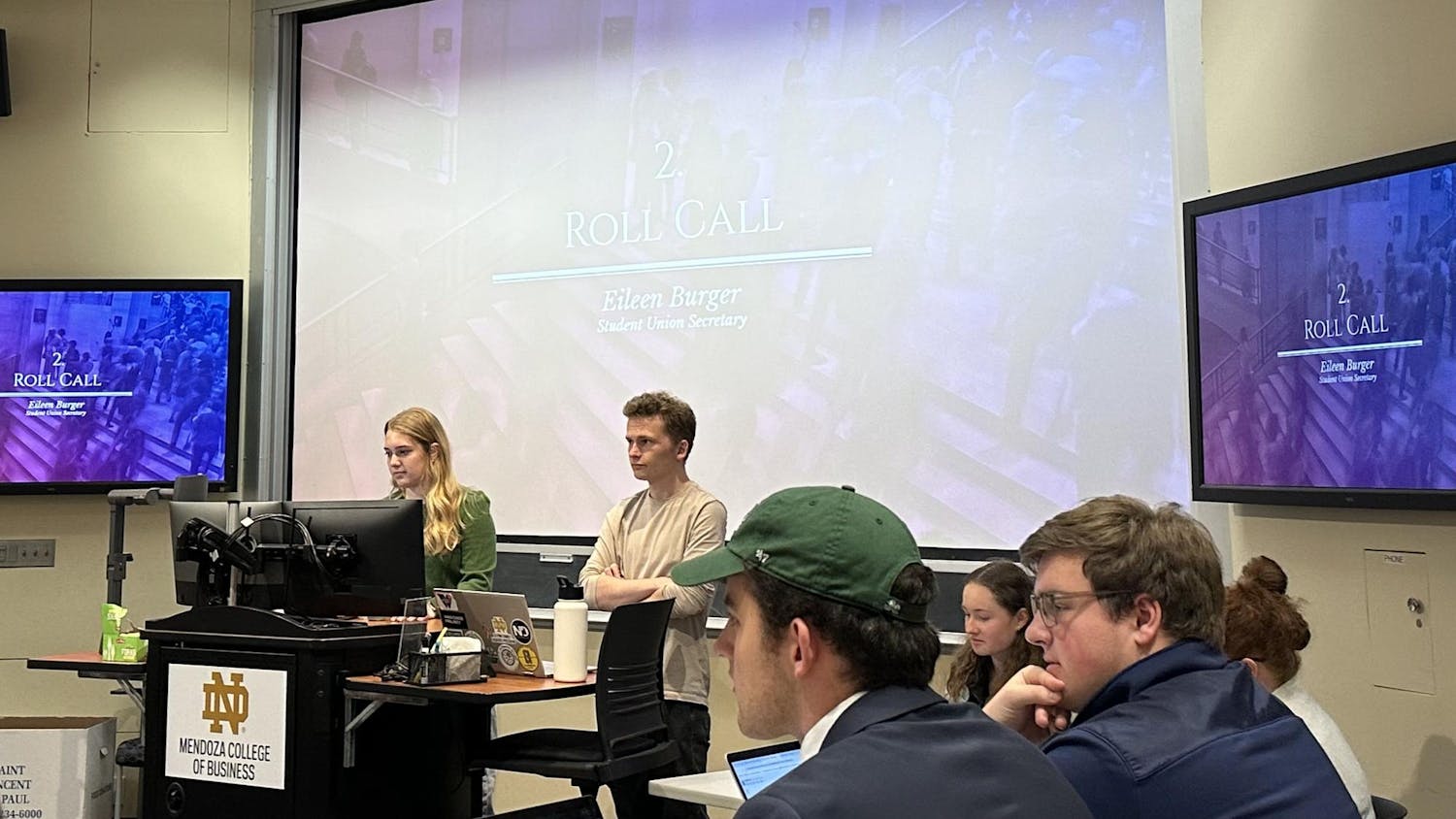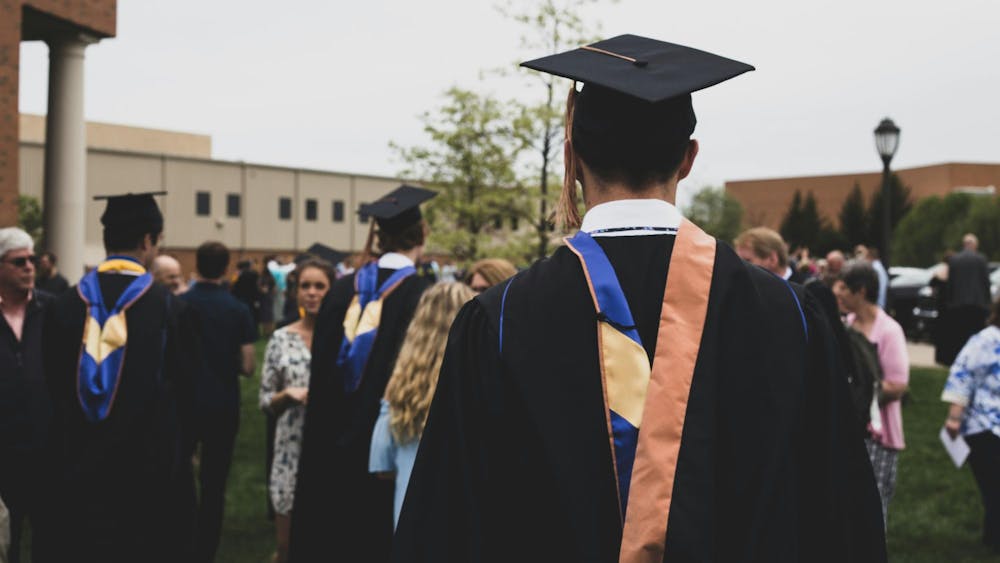The results of the University's investigation into the death of junior Declan Sullivan show Notre Dame is "collectively responsible" for the October accident, University President Fr. John Jenkins said in a Monday press conference at the Morris Inn.
Sullivan, 20, died Oct. 27 after the scissor lift from which he was filming football practice fell. He was a student videographer for the football team.

"Many individuals and departments share the collective responsibility for the inadequacy of the procedures that led to this tragedy," Jenkins said. "The University then is collectively responsible. Insofar as the president is responsible for the University as a whole, I am the individual who bears the greatest responsibility. I accept that responsibility."
Monday's press conference marked the end of a six-month-long investigation launched immediately following Sullivan's death.
"Each individual based his decisions and actions that day on the best information at the time and in accord with the procedures that were in place," Jenkins said about the events leading to the accident. "The procedures regarding wind safety obviously did not prevent this accident and must be brought up to the more rigorous standards that we have for other weather conditions such as heat, humidity and lightning."
The report gave eight recommendations for future action, all of which Jenkins said Notre Dame will implement.
Executive Vice President John Affleck-Graves oversaw the University's investigation. He said the investigation reviewed the decision process and timeline of events on the day of the accident, wind conditions, specific characteristics of the lift and the culture of safety in the Notre Dame football program.
The University will adopt the international maximum wind speed standard of 28 miles per hour to operate any lift on campus, and employees will be given real-time wind information whenever the lifts are in operation. Affleck-Graves said the University would begin using handheld devices to check wind speed.

Other recommendations included the appointment of safety contacts in each department who would have authority over the safety of all on-field personnel and reviews of the University protocol for lift operation and use.
"Finally, we will develop a national education safety program so that we can share with others the lessons we have learned from this tragic accident," Affleck-Graves said. "We will work with others such as [the Indiana Occupational Safety and Health Association (IOSHA)], the NCAA and the Collegiate Sports Video Association in this education effort."
The University installed a remote video system at its football practice fields before spring practice began March 23 and will no longer use scissor lifts to film football practice. Notre Dame will continue to use lifts for other purposes, Affleck-Graves said.
Director of Athletics Jack Swarbrick said his department is outlining more detailed practice safety guidelines for each sport and will more thoroughly train its employees.
"The lessons we learn here go to the whole University, and in my case the entire Athletics Department," Swarbrick said. "The first part is a clearer delineation of personal responsibility from program to program."
Affleck-Graves said the investigation included extensive research collected over the months following the October accident.
"This report provides a thorough account of what happened, including details of the tests and analysis performed by the experts, interviews with over 50 individuals, forensic examinations of the computers of personnel in the Athletic Department," Affleck-Graves said.
The University conducted the internal review with the help of Jon Peterka, a leading expert on wind-engineering applications and research, and David Merrifield, a safety consultant with expertise on aerial lift platforms.
"The report concludes the following factors led to the accident: a sudden and extraordinary 53 mile-per-hour gust of wind; staff members' lack of knowledge regarding wind speeds on the field during the practice; the characteristics of Declan's lift, which was lighter than the other two lifts, making it more susceptible to tipping; and the height of the lift, which at 40 feet made it more susceptible to tipping," Affleck-Graves said.
The investigation showed the staff checked the weather online eight times throughout the day, Affleck-Graves said, but the wind speed did not exceed 35 miles per hour at the staff's last weather update before practice began.
"The report highlights that as the primary weakness in our procedures," he said. "The lack of wind measuring on the field during the practice and the absence of any single individual with responsibility for monitoring wind."
Peter Likins, president emeritus of the University of Arizona, conducted an independent review of the investigation. He did not receive compensation for his work.
"I do want to say as clearly as I can that I affirm my belief in the integrity of the process and the quality of the conclusions and the recommendations," Likins said.
Jenkins said the University would continue its conversations with the Indiana Occupational Safety and Health Administration (IOSHA) after the state found Notre Dame guilty of six safety violations related to the accident. The fines from the citations total $77,500.
"What I intend to do is devote all my energy and all my efforts to enhancing the safety on campus, as well as beyond Notre Dame, with regard to aerial lifts," Jenkins said. "That's my focus."
After the state released its report March 15, the University filed a Notice of Contest on April 7 to continue talks with IOSHA.
"Nothing we can do can restore Declan to his family and to his community," Jenkins said. "But the most important way to memorialize Declan is to do all we can to understand the factors that led to his death and to take steps to prevent such an accident from happening at Notre Dame or anywhere else."
The results of the University's investigation into the death of junior Declan Sullivan shows Notre Dame is "collectively responsible" for the October accident, University President Fr. John Jenkins said in a press conference today.
Sullivan, 20, died Oct. 27 after the scissor lift from which he was filming football practice fell. He was a student videographer for the football team.
"Many individuals and departments share the collective responsibility for the inadequacy of the procedures that led to this tragedy," Jenkins said. "The University then is collectively responsible. Insofar as the president is responsible for the University as a whole, I am the individual who bears the greatest responsibility. I accept that responsibility."
The report gave eight recommendations for future action, including access to real-time weather information during lift operation.
"Each individual based his decisions and actions that day on the best information at the time and in accord with the procedures that were in place," he said. "The procedures regarding wind safety obviously did not prevent this accident and must be brought up to the more rigorous standards that we have for other weather conditions such as heat, humidity and light."
Executive Vice President John Affleck-Graves oversaw the University's investigation.
"This report provides a thorough account of what happened, including details of the tests and analysis performed by the experts, interviews with over 50 individuals, forensic examinations of the computers of personnel in the Athletic Department," Affleck-Graves said.
Affleck-Graves said the investigation reviewed the decision process and timeline of events on the day of the accident, wind conditions, specific characteristics of the lift and the culture of safety in the Notre Dame football program.
"The report concludes the following factors led to the accident: a sudden and extraordinary 53 mile per hour gust of wind; staff members' lack of knowledge regarding wind speeds on the field during the practice; the characteristics of Declan's lift, which was lighter than the other two lifts, making it more susceptible to tipping; and the height of the lift, which at 40 feet made it more susceptible to tipping," Affleck-Graves said.
Peter Likins, president emeritus of the University of Arizona, conducted an independent review of the investigation.
"I do want to say as clearly as I can that I affirm my belief in the integrity of the process and the quality of the conclusions and the recommendations," Likins said.
Jenkins said the University would continue its conversations with the Indiana Occupational Safety and Health Administration (IOSHA) after the state found Notre Dame guilty of six safety violations related to the accident. The fines from the citations total $77,500.
After the state released its report March 15, the University filed a Notice of Contest on April 7 to continue talks with IOSHA.
"Nothing we can do can restore Declan to his family and to his community," Jenkins said. "But the most important way to memorialize Declan is to do all we can to understand the factors that led to his death and to take steps to prevent such an accident from happening at Notre Dame or anywhere else."












